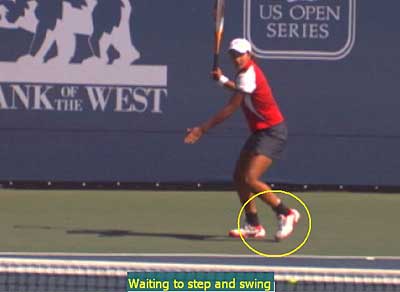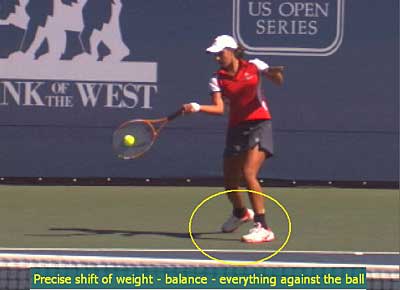|
TennisOne Lessons Pedigree of a Champion – Sania Mirza by Jim McLennan This is a pure opinion piece, but with some preliminary qualifications. I believe I have a “classical” training; Tom Stow instilled in me an appreciation for balance, for timing, for “swinging slowly but hitting hard” as he called it. That said, much of professional tennis strikes me as muscular (Roddick), effortful (Hewitt), and lacking imagination.
Further, much of what I read in coaching journals is colored by strength trainers, who seem to believe (rightly or wrongly) that stronger makes better. Well there may not be many Maria Bueno’s out there playing modern tennis, but I firmly believe there is still a place for grace, for balance, for rhythm, and for hitting the ball well without working hard. Consider when Edwin Moses ran his phenomenal streak of consecutive wins in the 400 meter hurdles; his warm-up routine appeared dance like if not meditative, while his competitors prepared for mighty exertions. I think Edwin discovered something about economy of effort, but the testament to his incredible success was that this economy of effort thing was truly a secret to everyone else.
Well enough about where I am coming from – I have watched Sania Mirza both in a qualifying match, and then in the first round of the main draw. She plays with uncanny precision, but without a trace of effort. She hits with disguise, she brings it to the opponent, but somehow without the customary grunting – I think Sania has the tools to go quite far in the women’s game, to my eye she is the next “real thing.” Sania Mirza is 18 years old, stands 5’7”, and turned pro in 2003. She works with both Bob Brett and her new traveling coach, John Farrington of the Bahamas. This “Phenom” became the first Indian woman to reach the third round of a Grand Slam tournament (the 2005 Australian Open) and the first Indian woman to win a WTA title, the Hyderabad Open. Presently ranked 64th in the world, she appears poised to reach the highest echelons of the game. But what so captured my eye was her uncanny accuracy, her easy timing, her willingness to go for her shots, and her poise. And this woman can sell tickets as well. The Wednesday evening session of the Bank of the West was sold out. Sania vs. Venus, and though Venus had too much depth and court coverage, the enormous Indian contingent in the stands supported her, vocally, chanting, every step of the way. Truly the women’s tour is a grind. And further, to win many a match players must “grind” the opponents. But this grinding style takes its toll in injuries, in sapping a player’s zeal, even may risk one’s health. A player keeping the ball in play works much harder day in and day out than one who plays to the corners and hits winners when the opportunity arises. Further, so many of the ladies (and men) are so fit, that balls driven to the corners are routinely returned, unless (and this is key) those balls to the corners are driven with disguise – and with the disguise that robs the opponent of a clue that enables them to get a jump and start early to the ball. To my eye, Sania plays with just this type of pinpoint offense, with equal parts disguise and economy. One of her opponent’s coaches has termed her style “first strike tennis” but I would add first strike with unusual accuracy, without a trace of effort, and with disguise that I more associate with the maestro Federer. Watch this young player - she is on the way up! She can play down the line or crosscourt with a simple adjustment to her timing, sooner it is crosscourt and later it is down the line, just that simple. This allows her to disguise her shots and keep her opponents off balance. And finally, she has a bold willingness to go to the corner first. She is not really waiting for openings, but rather creating her own. Remember, for I think Sania believes the following, “Losers hope it happens, and winners make it happen.” Effortless Power The following sequences are a primer on preparation, on balance, and on coming against the ball. There are a number of elements within these pictures that provide excellent examples for all of us, at whatever level we play or at whatever level we aspire to. Preparation – Sania has turned to the side, her weight is poised on the back foot, her knees are bent, her posture is excellent, and the racquet work is subtle. Consider this waiting on the ball, but it might just as easily be known as “weighting” on the ball for at this moment her weight is clearly back. I remember a Tom Stow drill for this pose, where the student would turn to the side, not commit the racquet, and then tap lightly and quickly the toe of the front foot. One could only perform this toe tapping when perfectly balanced on the back leg. “Tap, tap, tap – waiting, waiting.”
Now observe the nearly identical shift of weight onto the front foot as the racquet approaches (backhand) or hits (forehand) the ball. In spite of the open stance, weight on the back foot, jumping and lunging professional ground strokes, these two examples are picture perfect. She is playing the ball early, moving into the hit. She is moving forward, but she is again perfectly on balance. Perfectly against the ball. And again at this moment, Tom would ask you to tap the back toe quickly and lightly, tap tap tap. The lesson for you and I (a lesson I believe Sania has clearly learned) concerns the fundamentals, the foundation, the basics. And these are:
Your comments are welcome. Let us know what you think about Jim McLennan's article by emailing us here at TennisOne.
|
||||||||||





